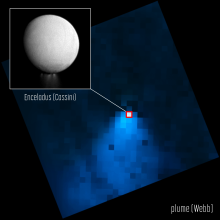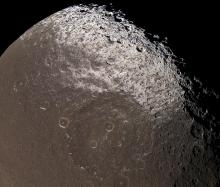Listen to today's episode of StarDate on the web the same day it airs in high-quality streaming audio without any extra ads or announcements. Choose a $8 one-month pass, or listen every day for a year for just $30.
You are here
Moon and Saturn
Saturn is the second-largest planet in the solar system — only mighty Jupiter outranks it. And it generates the second-largest magnetic “bubble” — a region of space dominated by Saturn’s magnetic field. It’s molded into a “teardrop” by the solar wind.
Saturn’s magnetic field is generated deep inside the planet. A core of rock and metal probably is surrounded by a layer of metallic hydrogen. The core and the hydrogen rotate at different rates. That creates a dynamo effect, like an electric motor, which generates the magnetic field.
Charged particles get trapped in the field. And many of those particles come from Enceladus, a small moon. It squirts geysers of water into space. Radiation zaps some of the water molecules, giving them an electric charge. The Cassini spacecraft found that some of the particles then flow toward Saturn in waves. So do particles from the planet’s rings.
Cassini recorded energy emitted by the waves. Mission scientists then converted some of the observations to sound. The sounds have been speeded up to make the patterns more audible.
Cassini’s observations confirm that an electric “circuit” connects Saturn and Enceladus — powered by the giant planet’s magnetic field.
And Saturn huddles quite close to our own Moon tonight. The giant planet looks like a bright golden star to the lower left of the Moon.
Script by Damond Benningfield






